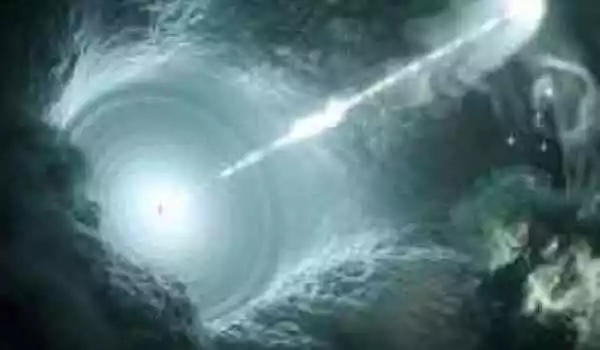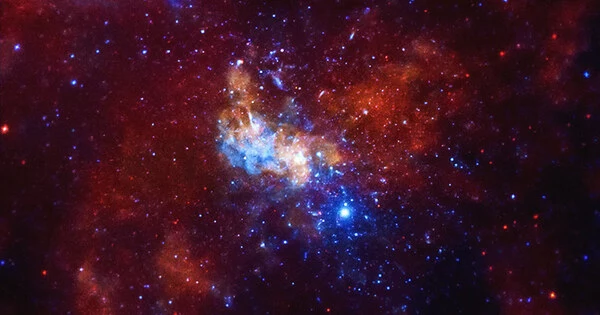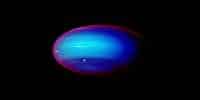Neutrinos are highly energetic particles that traverse billions of light years before reaching our planet. Although it is known that these basic particles originate in the depths of our Universe, their exact genesis is unknown. An international research team led by the Universities of Würzburg and Geneva (UNIGE) is throwing light on one part of this mystery: neutrinos are considered to be born in blazars, which are galactic nuclei fed by supermassive black holes. The findings have been published in the journal Astrophysical Journal Letters.
Cosmic rays are constantly bombarding the Earth’s atmosphere. These are electrically charged particles with energy ranging from 1020 electron volts to 1020 electron volts. That is a million times more energy than the Large Hadron Collider near Geneva, the world’s most powerful particle accelerator. The very energetic particles have traveled billions of light years from deep space. Where do they come from, and what propels them across the Universe with such ferocity? For nearly a century, these questions have been among the most difficult in astrophysics.
Neutrinos are produced in the birthplaces of cosmic rays. Neutrinos are undetectable neutral particles. They have almost no mass and interact with matter very little. They speed through the Universe, passing through galaxies, planets, and the human body nearly undetected. “Astrophysical neutrinos are produced exclusively in processes requiring cosmic ray acceleration,” says Sara Buson, an astrophysics professor at Julius-Maximilians-Universität (JMU) Würzburg in Bavaria, Germany. This is what distinguishes neutrinos as unique messengers, paving the route for the identification of cosmic ray sources.
Astrophysical neutrinos are produced exclusively in processes requiring cosmic ray acceleration. This is what distinguishes neutrinos as unique messengers, paving the route for the identification of cosmic ray sources.
Sara Buson
A step forward in a controversial debate
Despite the immense amount of data acquired by astrophysicists, the association of high-energy neutrinos with the astrophysical sources that generate them has remained an unsolved challenge for many years. Sara Buson has always seen it as a significant challenge. In the journal Science, the researchers and collaborators originally mentioned a blazar (TXS 0506+056) as a possible neutrino source in 2017. Blazars are active galactic nuclei fuelled by supermassive black holes that release far more radiation than their galaxy as a whole. The paper generated a scientific controversy about whether or not there is a link between blazars and high-energy neutrinos.
Following this exciting first step, Prof. Buson’s group launched an extensive multi-messenger research project with the funding of the European Research Council in June 2021. This entails analyzing various signals from the Universe (“messengers,” such as neutrinos). The primary goal is to give information on the origin of astrophysical neutrinos, with high certainty proving blazars as the earliest source of extragalactic high-energy neutrinos.
The project is now showing its first success: In the journal Astrophysical Journal Letters, Sara Buson, along with her group, the former postdoc Raniere de Menezes (JMU), and with Andrea Tramacere from the University of Geneva, reports that blazars can be confidently associated with astrophysical neutrinos at an unprecedented degree of certainty.

Revealing the role of blazars
Andrea Tramacere is a leading expert in the numerical modeling of acceleration processes and radiation mechanisms in relativistic jets, or outflows of accelerated matter reaching the speed of light. “The accretion process and the rotation of the black hole cause the development of relativistic jets, which accelerate particles and produce radiation with energy a thousand billion times that of visible light! The finding of the link between these items and cosmic rays could be referred to as the “Rosetta stone” of high-energy astrophysics!”
To arrive at these results, the research team utilized neutrino data from the IceCube Neutrino Observatory in Antarctica — the most sensitive neutrino detector currently in operation — and BZCat, one of the most accurate catalogues of blazars. “With this data, we had to prove that the blazars whose directional positions coincided with those of the neutrinos were not there by chance.” To do this, the UNIGE researcher developed a software capable of estimating how much the distributions of these objects in the sky look like the same.
“After rolling the dice several times, we discovered that the random association can only exceed that of the real data once in a million trials! This is strong evidence that our associations are correct.”
Despite this result, the research team feels that this first sampling of artifacts is simply the “tip of the iceberg.” This approach has enabled them to collect “new observable evidence,” which is the most crucial component for developing more accurate models of astrophysical accelerators. “What we need to do now is figure out what the primary difference is between objects that emit neutrinos and those that do not. This will help us understand how much the environment and the accelerator ‘speak’ to each other. We shall thus be able to rule out some models, improve the predictive capacity of others, and, lastly, add more parts to the perpetual puzzle of cosmic ray acceleration!”














